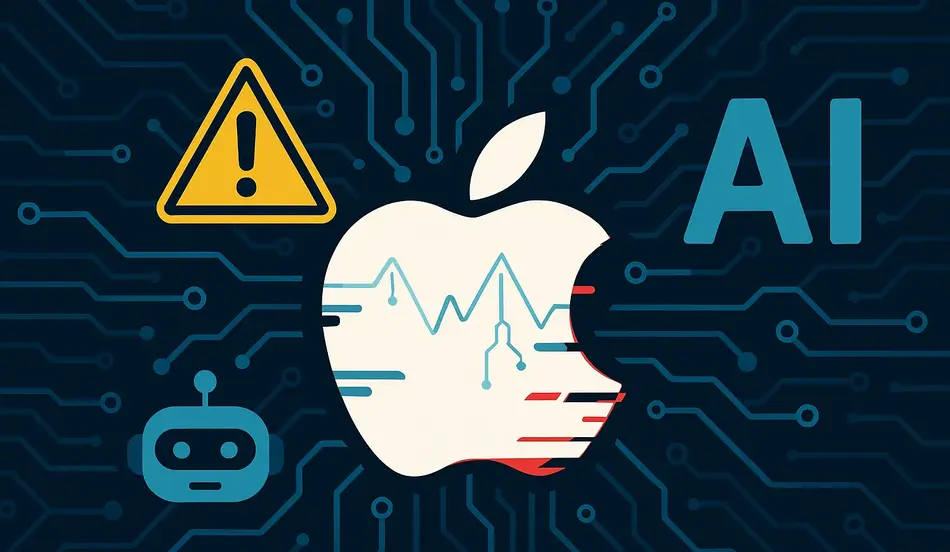Why Apple has a big AI problem is a story about how one of the world’s most successful technology companies found itself struggling to keep pace with the most transformative technological shift in decades. Despite having a massive head start with Siri, Apple has fallen behind in the AI race, creating an existential threat to its core iPhone business that accounts for more than half of the company’s revenue.
The problem began with Apple’s traditional approach to technology development: wait for others to perfect new technologies, then perfect them with superior design and user experience. This strategy worked brilliantly with multitouch interfaces, custom chips, and other innovations, but it has proven disastrous with AI, where the technology is evolving too rapidly for Apple’s cautious, methodical approach.
The company’s AI shortcomings are now impossible to ignore. Siri, once the gold standard for voice assistants, has become a punchline, with promised features delayed by years and basic functionality that pales in comparison to ChatGPT, Google Assistant, and other AI tools. Apple Intelligence, the company’s much-hyped AI platform, launched as a “dud” with missing features and disappointing performance.
The stakes couldn’t be higher. AI has the potential to be a “make or break moment” for Apple, as the company faces the possibility of being disrupted by the same type of innovation that once made it dominant. With competitors like Meta, Google, and even Apple’s former design chief Johnny Ive working on AI-powered devices, Apple risks becoming the next Nokia or BlackBerry if it doesn’t solve its AI problem quickly.
The Siri Saga: From Pioneer to Punchline
Apple’s AI problem is most evident in the decline of Siri, which went from being a revolutionary voice assistant to a source of frustration and mockery. The company’s early lead with Siri, acquired in 2011, quickly evaporated as competitors developed more advanced AI capabilities.
The recent controversy over Apple’s Siri ad featuring actor Bella Ramsey highlights the depth of the problem. The ad showcased a new version of Siri that could remember past meetings and provide contextual information, but the feature was delayed from April 2025 to spring 2026, forcing Apple to take down the ad and face a lawsuit over the delay.
Siri’s struggles reflect Apple’s broader AI challenges. The voice assistant has become increasingly outdated compared to ChatGPT, Google Assistant, and other AI tools that can handle complex queries, provide detailed responses, and integrate seamlessly with various applications and services.
The company’s attempts to improve Siri have been hampered by internal struggles, including the scrapping of a project to build a “lighter, faster Siri” and the departure of key AI talent to competitors offering massive compensation packages.
The Apple Intelligence Debacle: A “Huge Black Eye”
Apple’s attempt to catch up with AI competitors through Apple Intelligence has been a spectacular failure. Launched with great fanfare at the 2024 Worldwide Developers Conference, the platform was supposed to represent “AI for the rest of us” but quickly became a “huge black eye” for the company.
The problems with Apple Intelligence were evident from the start. Despite being announced as a key feature of the iPhone 16, the platform didn’t launch until a month and a half after the phone’s release, and many promised features, particularly those related to Siri, remain missing.
The platform’s limitations reflect Apple’s cautious approach to AI development. While competitors are investing tens of billions of dollars in AI infrastructure and capabilities, Apple has been more conservative, focusing on privacy and on-device processing that limits the sophistication of its AI features.
The result is an AI platform that feels outdated and incomplete compared to what competitors are offering, further damaging Apple’s reputation in the AI space and disappointing users who expected more from the company.
The Apple Intelligence Debacle
Apple’s missteps in AI highlight the risks of falling behind in a fast-moving technology race. Employers can avoid the same fate by hiring innovative talent ready to push boundaries and deliver results. Post your job on WhatJobs today and connect with professionals who won’t let your business get left behind.
Post a Job Free for 30 Days →The Foundation Model Dilemma: Build vs. Buy
Apple’s AI problem is fundamentally about foundation models, the core AI technology that powers modern AI tools. While competitors like OpenAI, Google, and Anthropic have invested heavily in developing their own foundation models, Apple has struggled to build competitive technology in-house.
The company is now considering partnerships with external providers, having held discussions with Google, OpenAI, and Anthropic about using their foundation models to power Apple’s AI features. This represents a significant shift from Apple’s traditional approach of building everything in-house.
The challenge is that foundation models are extremely expensive and time-consuming to develop, requiring tens of billions of dollars in investment without guaranteed returns. Apple’s conservative approach to spending has hindered its ability to compete in this space.
The company’s privacy-focused approach also creates limitations, as it requires on-device processing for many AI features, which limits the sophistication of what can be accomplished on a smartphone compared to cloud-based AI services.
The Talent Drain: Losing the AI War
Apple’s AI problem is compounded by a talent drain, as competitors are aggressively poaching the company’s AI engineers with offers that dwarf traditional tech compensation. Meta reportedly offered one Apple foundation models team leader a pay package worth well over $200 million over several years.
This talent exodus reflects the intense competition for AI expertise, as companies recognize that success in AI depends on having the best engineers and researchers. Apple’s traditional compensation structure, while generous by most standards, pales in comparison to what AI-focused companies are offering.
The loss of key talent further hampers Apple’s ability to develop competitive AI technology, creating a vicious cycle where the company falls further behind while competitors accelerate their development efforts.
The situation is particularly concerning given that Apple once successfully poached Google’s top AI executive, John Giannandrea, but has since struggled to retain and develop AI talent internally.
The Competitive Threat: The Next Apple
Apple’s AI problem isn’t just about catching up with current competitors; it’s about the risk of being disrupted by entirely new players. The company’s former design chief, Johnny Ive, is now working on AI-powered devices, and other companies are developing products that could fundamentally change how people interact with technology.
The threat is similar to what happened to Nokia and BlackBerry, which were dominant in their respective markets until Apple introduced better products that made their existing offerings obsolete. Apple now faces the same risk from AI-powered devices and services.
The company’s traditional strengths – design, user experience, and ecosystem integration – may not be enough to compete in an AI-driven world where the technology itself is the primary differentiator.
The risk is that Apple could become the next Nokia or BlackBerry if it doesn’t solve its AI problem quickly, as new competitors emerge with AI-powered products that make traditional smartphones and computing devices obsolete.
The Investment Gap: Playing Catch-Up
Apple’s AI problem is also about investment. While competitors like Amazon, Google, Microsoft, and Meta are pouring billions into AI infrastructure and capabilities, Apple’s expenditures are far less, reflecting its traditional focus on building products for itself rather than providing AI services to others.
This investment gap has created a significant disadvantage, as AI development requires massive resources for data centers, computing power, and talent acquisition. Apple’s conservative approach to spending has left it behind in the AI arms race.
The company’s focus on privacy and on-device processing also limits its ability to leverage the massive amounts of data that competitors use to train their AI models, further hindering its ability to compete.
The result is that Apple is playing catch-up in a race where the leaders are already far ahead and accelerating, making it increasingly difficult to close the gap.
Frequently Asked Questions
Why Apple has a big AI problem – what are the main issues?
Why Apple has a big AI problem stems from missing the AI revolution, Siri delays and failures, conservative investment approach, talent drain, and the risk of being disrupted by AI-powered competitors.
How did Apple fall behind in AI despite having Siri first?
Apple fell behind because its traditional “wait and perfect” strategy doesn’t work with rapidly evolving AI technology, and competitors quickly surpassed Siri’s capabilities while Apple remained cautious and conservative.
What went wrong with Apple Intelligence?
Apple Intelligence launched as a “huge black eye” with missing features, delayed releases, and disappointing performance compared to competitors, despite being hyped as “AI for the rest of us.”
Why is Apple losing AI talent to competitors?
Apple is losing AI talent because competitors like Meta and OpenAI are offering compensation packages worth hundreds of millions of dollars, far exceeding Apple’s traditional pay structure.
Why is Apple losing AI talent to competitors?
Apple is losing AI talent because competitors like Meta and OpenAI are offering compensation packages worth hundreds of millions of dollars, far exceeding Apple’s traditional pay structure.
How does Apple’s privacy focus hurt its AI capabilities?
Apple’s privacy focus limits AI capabilities by requiring on-device processing instead of cloud-based AI services, restricting access to large datasets needed for advanced AI features.
What is Apple’s foundation model dilemma?
Apple struggles to build competitive foundation models in-house due to the massive investment required, forcing the company to consider partnerships with Google, OpenAI, and Anthropic.
A Real-World Example: The iPhone User’s Frustration
Michael Rodriguez, a long-time iPhone user and tech enthusiast, exemplifies the frustration many Apple customers feel about the company’s AI shortcomings. “I’ve been using iPhones for over a decade, and I’ve always loved Apple’s attention to detail and user experience,” he explains. “But when it comes to AI, it feels like Apple is stuck in the past.”
Michael’s experience with Siri has been particularly disappointing. “I’ll ask Siri a simple question, and it either gives me a basic web search result or says it can’t help me,” he says. “Meanwhile, my friends with Android phones are using Google Assistant to do things that seem like magic – booking appointments, writing emails, even having conversations that feel natural.”
The launch of Apple Intelligence was particularly frustrating for Michael. “I was excited when they announced it, thinking finally Apple was going to catch up,” he explains. “But when it actually launched, half the features they promised weren’t there, and the ones that were there didn’t work very well.”
Michael’s experience highlights the broader problem with Apple’s AI strategy. “It feels like Apple is trying to play catch-up but doesn’t really understand what makes AI useful,” he says. “They’re focused on privacy and on-device processing, which is great in theory, but it means their AI is always going to be less capable than what competitors can offer.”
The situation has made Michael consider switching to Android for the first time in years. “I love Apple’s ecosystem and design, but if the AI gap keeps growing, I might have to make a change,” he says. “AI is becoming too important to ignore, and Apple just doesn’t seem to get it.”
Michael’s story illustrates the broader challenge facing Apple: maintaining customer loyalty while falling behind in a critical technology area. “I want to believe Apple can figure this out,” he says, “but they’re running out of time.”
Don’t Underestimate the AI Threat to Apple
Apple’s AI problem represents one of the most significant challenges in the company’s history, threatening not just its competitive position but its very existence as a dominant technology company. The stakes couldn’t be higher, as AI has the potential to fundamentally change how people interact with technology.
The company’s traditional strengths – design, user experience, and ecosystem integration – may not be enough to compete in an AI-driven world where the technology itself is the primary differentiator. Apple needs to act quickly and decisively to address its AI shortcomings before it’s too late.
The solution will likely require a fundamental shift in strategy, moving away from the company’s traditional approach of building everything in-house to partnerships and acquisitions that can quickly provide competitive AI capabilities.
The future of Apple depends on its ability to solve its AI problem, as the company faces the very real risk of being disrupted by the same type of innovation that once made it dominant. The time for caution has passed; the time for action is now.




